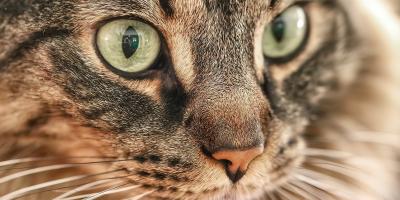
As a cat owner, you will have come to recognize your companion’s various moods from her body language, facial expressions, noises and the ways she moves. We instinctively know whether our cats are excited, happy, sad, frustrated or anxious. Read on to learn more about cat behaviour and how to understand cats.
Understanding Cat Behaviour
While a cat might be sitting silently, they are always giving off signals of their current mood. Is your cat fearful? Does she want to play? Is she relaxed? Taking the simple step of understanding cat behaviour and what she’s trying to communicate can lead towards a stronger bond with your pet. Cats also use meowing as a way to communicate with humans. To learn more, read our article on why cats meow.
Friendly
A friendly cat's eyes will be alert and blinking, and her ears will be pointed forward while she holds her head up and fans out her whiskers. You can also listen to a cat for signs of friendliness. For instance, if you hear meowing, she may be looking to interact. Make sure that your interaction is based on the cat’s personality and the context of the situation.
Fearful
While your cat's posture may appear calm, take a closer look at her face and tail to see if they show fear or distress. A fearful cat may have dilated pupils and flattened ears, and her tail may be held downward, close to her body, while she flattens her whiskers and presses them against her face. Be mindful of sudden or rapid movements when your cat seems fearful, as they may make her more uncomfortable.
Playful
When a cat is standing with her tail curled, rolling side-to-side or belly up, she’s likely looking for contact and play. Her ears may be pointed forward, as well. Make sure not to touch her on the stomach because this will elicit reflexive, defensive or predatory behaviours that might make her claw or bite your hand.
Relaxed
You can tell if your cat is relaxed by looking at a combination of cues. Make sure you examine her facial expression and body language, as a crouched, relaxed position can look similar to fear. Her ears will be pointed forward, and her tail will be visible, rather than tucked or curled, while her whiskers will remain slightly fanned out, rather than pulled back against her face.
Negative
When a cat is showing negative body language, she is most likely not open to contact. It is best not to try to approach her or pick her up, especially if the cat is hissing or growling. Her pupils may be dilated, and her ears will be flattened against her head. She may arch her back, and the hair on both her back and her tail may be raised.
Do Cats Have Feelings?
Emotions are what give cats the impulse to act in response to an event or situation. For example, the negative emotion of fear may cause cats to run and hide, while the positive emotion of happiness may cause cats to climb into your lap for a cuddle.
Emotions are divided into positive or negative feelings which have rising and decreasing scales. For instance, pleasure can increase to feelings of elation and ecstasy, while frustration can increase to anger and rage.
Modern pet behaviourists realize that emotions are essential to how animals learn anything at all, even if the measurement of these feelings is not exact. They use emotional assessment as the basis of treating pet behaviour problems.
Emotional problems
Animal behaviourists can better understand behavioural problems such as aggression and nervousness through recognizing that cats have emotions. If your pet’s negative emotions outweigh the positives, it is important to seek help from an animal behaviourist.
Rewarding a behaviour will reinforce it and also the feelings that go with it. Giving your cat more of what she enjoys will ensure you have a stress-free cat.
Related articles



